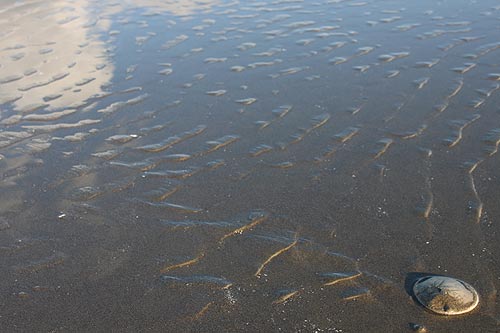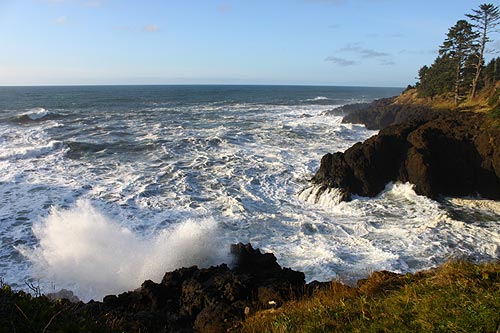 |
New Oregon Study Warns of Oceans' Dark Future
Published 11/06/2013

(Newport, Oregon) - A new study contributed to by Oregon State University and the Hatfield Marine Science Center on the central Oregon coast says climate change will gravely impact most of the Earth's oceans by the year 2100, creating a domino effect of biological and economic hardships. (Above: Cannon Beach, on the north Oregon coast).
The report was released this month by the OSU College of Earth, Ocean, and Atmospheric Sciences in Corvallis, Oregon, funded by the Norwegian Research Council and Foundation through its support of the International Network for Scientific investigation of deep-sea ecosystems (INDEEP).
Researchers say 98 percent of the oceans will be affected by acidification, warming temperatures, low oxygen, or lack of biological productivity – and most areas will be stricken by a multitude of these stressors.
OSU's study warns of several possible biological responses to these four stressors.
Warming of the oceans will likely lead to species loss, reduced animal density and more risk of disease.
Acidification will increase mortality of calcifying marine invertebrates and likely lead to species loss. Hypoxia, or low oxygen, will cause mortality in many species and could enhance dominance by other species that are hypoxia-tolerant. Also, some species will suddenly become more dominant than others as food web structures become altered.

This will have more than just a biological impact, researchers says. Economic impacts will be felt up and down the ladder. (Above: Sea life at Seaside, Oregon, on the north Oregon coast).
“While we estimated that 2 billion people would be impacted by these changes, the most troubling aspect of our results was that we found that many of the environmental stressors will co-occur in areas inhabited by people who can least afford it,” said Andrew Thurber, an Oregon State University oceanographer and co-author on the study.
Thurber said somewhere between 400 million and 800 million people are both dependent on the ocean for their livelihood and also make less than $4,000 annually. Changes forced upon this industry and its workers will be costly, including things like retooling a fishing fleet to target a changing fish stock, or moving to a new area or occupation.
“What is really sobering about these findings is that they don’t even include other impacts to the world’s oceans such as sea level rise, pollution, over-fishing, and increasing storm intensity and frequency,” Thurber said. “All of these could compound the problem significantly.”
Upwelling areas are already a serious issue – where deep, nutrient-rich water is brought to the surface to fertilize the upper water column. These have manifested themselves in the form of the infamous “dead zones” off the Oregon coast in recent years with oxygen deprivation issues killing off huge areas.
The Northern Hemisphere, southern Africa and coastal waters off Chile are also especially prone to the negative effects of low oxygen and rising acidification.

The models also suggest that marine food webs based on the production of euphausiids and other krill, or tiny marine crustaceans, are highly at-risk. (Above: Depoe Bay whale and wave watching, on the north Oregon coast).
“A lot of marine animals, including many whale populations, are dependent upon krill or the other organisms that consume krill, for survival – and krill habitat has some of the greatest overlap in all the stressors we looked at,” Thurber said. “On the other hand, coral reefs – even though they didn’t rank as high as other areas for stressor overlap – are in trouble due to just two of the stressors, acidification and temperature. So a low score doesn’t necessarily mean these areas are unlikely to be affected.”
More on the Oregon coast, and more about Oregon coast science here and below.

More About Oregon Coast hotels, lodging.....
More About Oregon Coast Restaurants, Dining.....
LATEST Related Oregon Coast Articles
Whale Body Parts Found on Oregon Coast - Two Whales Strand on Washington Coast |
Secrets of the Season |
Unusual Travel Articles TravelParanormal.com allows you to submit your own creepy tale or debunk one - or see up-to-the-minute news headlines about travel and the paranormal. News Headlines from All Over Oregon Need to scan Oregon headlines? Constantly updated news from all over Oregon: a comprehensive, up-to-the-minute display of news headlines from a variety of media |
Back to Oregon Coast
Contact Advertise on BeachConnection.net
All Content, unless otherwise attributed, copyright BeachConnection.net Unauthorized use or publication is not permitted









































